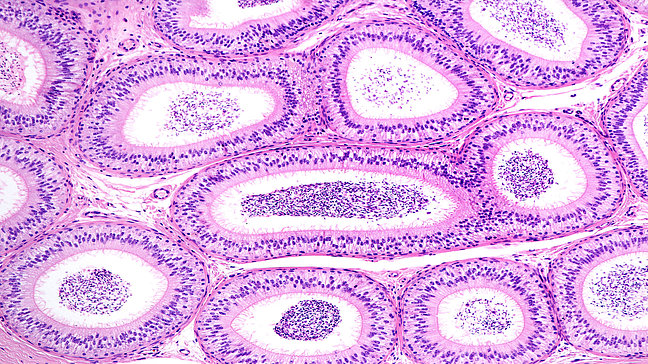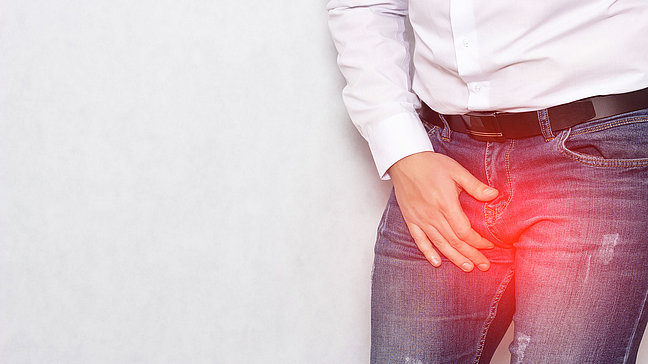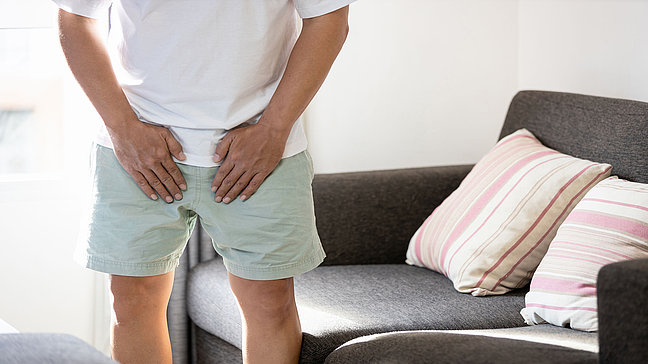
Testicular swelling
Causes of testicular swelling
Testicular swellings can be caused by a variety of factors. The most common causes are:
- Infections: Bacterial or viral infections, such as epididymitis (inflammation of the epididymis) or orchitis (inflammation of the testicles), can cause swelling of the testicles.
- Injuries: Trauma or injuries in the scrotal area can lead to swelling, often accompanied by bruising or pain.
- Testicular torsion: A sudden twisting of the testicle around its own axis, interrupting the blood supply and causing a painful, acute swelling, represents a urological emergency.
- Hydrocele: A fluid accumulation between the layers of the testicles (hydrocele), which is usually painless and leads to visible swelling of the testicle.
- Hernia: In a scrotal hernia, intestinal content can shift into the scrotum and cause swelling.
- Tumors: Testicular cancer can lead to painless swelling, which often goes unnoticed.
Symptoms of testicular swelling
- Enlargement of the affected testicle or both testicles
- Pain or discomfort in the scrotum or groin (depending on the cause)
- A feeling of tension in the scrotum
- Redness or warmth of the skin around the testicle
- Fever and general malaise in case of an infection
Diagnosis of Testicular Swelling
The diagnosis usually begins with a physical examination of the scrotum, during which the doctor looks for signs of swelling, pain, or hardening. Depending on the suspected cause, additional tests may be conducted:
- Ultrasound: An ultrasound of the scrotum helps to assess the swelling more precisely and to differentiate between infectious, traumatic, or tumor-related causes.
- Blood and urine tests: These tests can help detect infections or other inflammatory causes.
- Imaging techniques: In some cases, CT or MRI may be performed to make a more accurate diagnosis.
Treatment options for testicular swelling
The treatment depends on the underlying cause of the swelling:
- Antibiotics: For bacterial infections, such as epididymitis or orchitis, antibiotics are prescribed.
- Surgical interventions: In the case of testicular torsion, immediate surgery is required to save the testicle and restore blood supply. Hernias or tumors also often require surgical interventions.
- Pain relief: Painkillers and anti-inflammatory medications can help alleviate pain and swelling, especially in cases of injury.
Preventive measures for testicular swelling
There are no specific measures for the prevention of testicular swelling, but regular self-examinations of the testicles can help detect changes early. In the case of testicular injuries, medical assistance should be sought immediately. Early treatment of infections or hernias can also help prevent swelling or avoid complications.
Common Patient Questions About Testicular Swelling
In the case of testicular swelling, cooling compresses and elevating the scrotum can help alleviate the swelling. Wearing comfortable and supportive underwear can also provide relief. Pain relievers like ibuprofen can temporarily ease the pain, but it is advisable to have the cause medically clarified.
A testicular swelling is an emergency if it occurs suddenly and with severe pain, especially in adolescents and young men. This could indicate a testicular torsion (twisting of the testicle) that must be treated as quickly as possible to avoid permanent damage.
Testicular swellings can be caused by various conditions such as epididymitis (inflammation of the epididymis), orchitis (inflammation of the testicles), hydrocele (water hernia), varicocele (varicose vein hernia), or tumors. An accurate diagnosis by a doctor is necessary to determine the cause.
Good hygiene, protection against injuries in the genital area, and wearing supportive sports clothing can reduce the risk of swelling. In the case of frequent infections, regular medical examinations and protective measures may be advisable.
![[Translate to English:]](/fileadmin/_processed_/1/d/csm_UZ-Logo-2024-breit-aK-1500px-white-red_4b49b8d28c.png)


